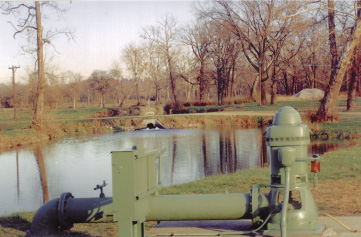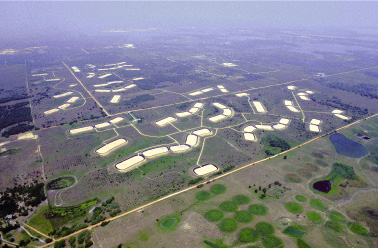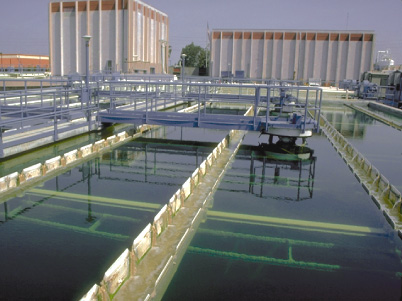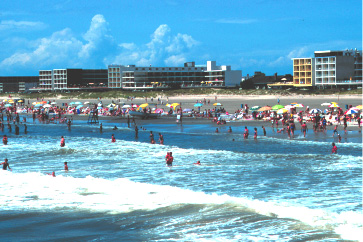
Sustainability of Ground-Water Resources--Circular 1186
A variety of innovative approaches have been undertaken to enhance the sustainability of ground-water resources. These approaches typically involve some combination of the use of aquifers as storage reservoirs, conjunctive use of surface water and ground water, artificial recharge of water through wells or surface spreading, and use of recycled or reclaimed water. These approaches commonly lead to scientific questions about the extent and nature of ground-water and surface-water interactions, geochemical effects of mixing water from different sources with aquifer water, production and degradation of by-products from injection of treated water, and other issues.
Selected examples of innovative approaches that have been implemented are described below.
Dayton, Ohio, is heavily dependent upon ground water to meet municipal and industrial water-supply needs. Nearly one-fourth of all ground water used in Ohio is withdrawn from wells completed in a sole-source sand and gravel aquifer that underlies the Dayton metropolitan area. Much of the water is pumped from a 30- to 75-foot thick shallow aquifer that underlies the Mad River Valley. To ensure that ground-water levels are maintained high enough to allow for large drawdowns by high-capacity wells, an artificial recharge system has been in place since the 1930's. The source of recharge is streamflow diverted from the Mad River into a series of interconnected infiltration ditches and lagoons that occupy about 20 acres on Rohrers Island. To meet increasing demand, a new municipal well field was developed in the 1960's in a section of the aquifer north of Dayton. Here, water is pumped from the Great Miami River into a series of ponds and lagoons, some of which also serve as water hazards on a city-owned golf course. Recharge lagoons at both well fields are periodically drained, and accumulated muck and silt are excavated to maintain a high rate of infiltration into the underlying aquifer.

High-capacity turbine pump installed on a municipal well at Rohrers Island. Recharge lagoon in background. (Photograph by Brent Means, U.S. Geological Survey.)
Large volumes of reclaimed water, which has undergone advanced secondary treatment, are reused through land-based applications in a 40-square-mile area near Orlando, Florida. These applications include citrus crop irrigation and artificial recharge to the surficial aquifer through rapid infiltration basins.

Rapid infiltration basins. (Photograph courtesy of Water Conserv II facility, Orlando, Florida.)
Orange County, near Los Angeles, California, receives an average of only 13 to 15 inches of rainfall annually, yet sustains a population of approximately 2.5 million people. A ground-water basin that underlies the northwestern half of the county supplies about 75 percent of the total water demand. As the area developed from a thriving agricultural center into a highly urbanized area, increased demands for ground water resulted in a gradual lowering of the water table below sea level and encroachment of saltwater from the Pacific Ocean. To prevent further saltwater intrusion and to replenish the ground-water supply, the Orange County Water District operates a hydraulic barrier system composed of a series of 23 multipoint wells that inject freshwater into the aquifer, blocking further passage of seawater. The source of injection water is a blended combination of deep well water and recycled secondary effluent. The recycled product meets drinking-water standards through advanced treatment processes of reverse osmosis and activated carbon adsorption.

Water Factory 21 treatment facility. (Photograph courtesy of Orange County Water District.)
Wildwood, New Jersey, is a resort town on a barrier island along the Atlantic Coast. As a resort community, it has a large influx of tourists in the summertime. The population can increase from about 5,000 during the winter to 30,000 at the height of the summer tourist season. The Wildwood Water Utility withdraws water from wells located about 5 miles inland from the barrier island. To supply water from these wells to meet the island's needs during the summer would require a large pumping facility and transmission lines that would be little used the rest of the year. To avoid these excessive costs, the utility injects ground water into a shallow aquifer on the island during periods of low demand and withdraws the water in the summer by using dual injection and recovery wells. This system, operated since 1967, represents perhaps the oldest operational aquifer storage recovery (ASR) project in the United States. In ASR, water is injected underground, commonly into nonpotable or saline aquifers, where it forms a lens of good quality water for later recovery from the same well(s). Operation of a typical ASR installation is designed to smooth out annual variability in water demand by recharging aquifers during periods of low demand and recovering the water during periods of high demand. Advantages of ASR over other artificial recharge schemes are that it uses very little land (especially compared to surface spreading) and reduces the cost and maintenance of separate injection and recovery wells.

Wildwood beach in the summer. (Photograph courtesy of Cape May County Division of Tourism.)
Ground water is the sole source of freshwater for the more than 3 million people who live on Long Island outside the metropolitan New York City boundary. (The Long Island ground-water system was discussed earlier in the sections on "Ground-Water Development, Sustainability, and Water Budgets" and "Effects of Ground-Water Development on Ground-Water Storage.") To help replenish the aquifer, as well as reduce urban flooding and control saltwater intrusion, more than 3,000 recharge basins dispose of storm runoff at an average rate of about 150 million gallons per day. Initially, many of these basins were abandoned gravel pits, but since 1936 urban developers are required to provide recharge basins with new developments. Practically all basins are unlined excavations in the upper glacial deposits and have areas from less than 0.1 to more than 30 acres.

Aerial photograph of development on Long Island showing recharge basin. (Photograph courtesy of Nassau County Department of Public Works.)